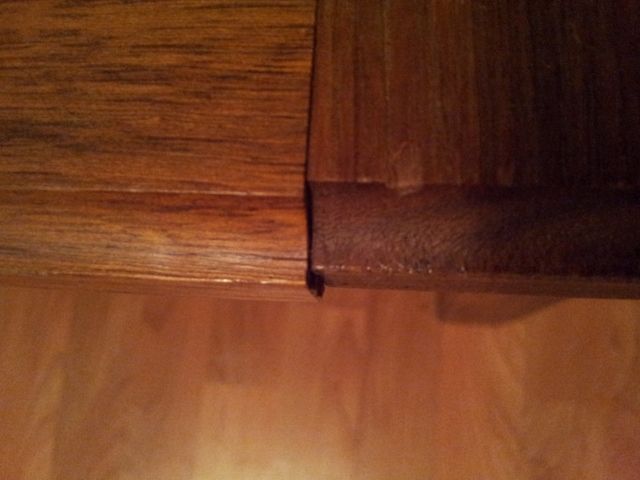Re: Transom
Hi Searay,
Solid wood versus Plywood for a Transom
I reccomend against using white oak for a transom. It will be weaker than a plywood transom. That's the short answer. Here is the long one.
Although an inch and a half thick piece of white oak will be very solid, solid woods are not dimensionally stable, as they expand and contract with the seasons. They will expand and contract most 'widthwise' or across the grain, with seasonal, heat, and humidity changes. In addition, unless you have quartersawn white oak, wooden boards have a tendency to bow or cup as they age. If woodworkers don't plan for this type of movement, the pieces of furniture they build will quite literally tear themselves apart. By way of example, take a look at the photograph below (of a table with pieces of wood oriented in different grain directions. This table's edge was originally flush. After one season, it moved out this far from each other. This tabletop was fully sealed with teak oil.

Plywood is
substantially more dimensionally stable than solid wood. When plywood is constructed, each 'ply' (or thin sheet of wood), is oriented at 90 degrees to the ply next to it. The result is that as seasons change, wood movement in the individual plys is constrained - so it cannot move as easily. Plywood is much less likely to expand or contract or warp than a similar thickness of a solid wood. This is why, even in so called solid wood cabinetry - most cabinets are built of plywood.
In addition, plywood is
substantially stronger than a similar thickness of solid hardwood. Ever seen a karate expert break a board? It's actually a fairly easy thing to do. What the expert is doing is hitting a solid wood board
along the grain. The wood is quite weak in that direction, and will split easily. If you have ever split wood, you will know how easy it is to split a log along the grain with an axe...and how it is impossible to split a log across the grain.
So why is all this important for you?
I believe your boat is fiberglass. If it is, and you then seal the solid wood piece of oak in place, the wood will expand and contract with the seasons. Quite literally, what the transom will do over time is strain - pressing outwards, then pulling inwards against the fiberglass envelope around it, which will increase the risk of it cracking the transom. The wood will separate from the transom - creating a gap that could retain water. Second, the board will have a tendency to warp as it ages (particularly if water gets into it, for example through cracks in the fiberglass), which will have a similar effect. Third - remember the karate analogy? Think how much pressure is put on a transom by a motor. Cracking along the grain could occur. A piece of plywood will not similarly crack, unless it completely rots out.
For all these reasons, and if budget is a factor, you would be better off getting a sheet of exterior grade (not pressure treated) 3/4 inch plywood, and laminating two sheets of it together, to make your transom. Even in Canada, that type of plywood will only run about $35 a sheet. If you look on the threads in the restoration section, you will see lots of recommendations for plywood.
Now, although I'm recommending against it, I'm not telling you that the transom will wreck the boat - you may be just fine. If you do decide to use the oak, check a couple of things. First - confirm that the oak you are using has either been kiln dried or properly air dried (assuming the board is currently two inches thick - this would usually mean at least two years of air drying, before it can be used). To check that is has been properly air dried, you need a wood moisture meter, to check that the wood has dropped to a low enough moisture content. If it has not been properly dried, don't use it, as it will have a high moisture content, and will shed that, changing shape and dimensions considerably over the years. Never use green (freshly cut) wood, as it will warp and change shape considerably. A 12 inch wide piece of white oak will shrink by at least an inch as it dries. Second, even if it is dried, once your buddy has milled the board to final thickness and size, wait for at least two weeks (a month would be better), to see if it changes shape or warps. It is common for both air dried and kiln dried woods to warp after having been milled, because this process gives the wood another opportunity to lose or gain moisture.
Finally, I know that you will probably be sealing the wood - all I can say is while that will reduce the gain and loss of moisture from the wood, and will reduce the expansion and contraction that can occur, the wood will still expand and contract. Solid wood tabletops, even when completely sealed by a varnish or urethane will still expand and contract with the seasons.
Best of luck - and welcome to Iboats - I look forward to seeing your project come together.




















